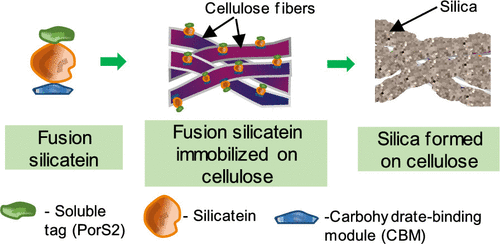当前位置:
X-MOL 学术
›
Biomacromolecules
›
论文详情
Our official English website, www.x-mol.net, welcomes your feedback! (Note: you will need to create a separate account there.)
Biological Route to Fabricate Silica on Cellulose Using Immobilized Silicatein Fused with a Carbohydrate-Binding Module.
Biomacromolecules ( IF 6.2 ) Pub Date : 2020-06-16 , DOI: 10.1021/acs.biomac.0c00730 Kasun Godigamuwa 1 , Kazunori Nakashima 2 , Junnosuke Okamoto 1 , Satoru Kawasaki 2
Biomacromolecules ( IF 6.2 ) Pub Date : 2020-06-16 , DOI: 10.1021/acs.biomac.0c00730 Kasun Godigamuwa 1 , Kazunori Nakashima 2 , Junnosuke Okamoto 1 , Satoru Kawasaki 2
Affiliation

|
Silicatein is an enzyme capable of catalyzing silica formation under mild conditions and is a promising catalyst for the fabrication of biohybrid materials. However, unfavorable aggregation of silicatein makes it unsuitable for use in material fabrication. In this study, a soluble protein tag (ProS2) and a carbohydrate-binding module (CBM) were used to develop a soluble and cellulose-binding fusion silicatein, ProS2-Sil-CBM, which can be efficiently immobilized on cellulose to form silica on it. ProS2-Sil-CBM was soluble in aqueous media and strongly bound to cellulose. ProS2-Sil-CBM bound on cellulose catalyzed the formation of a silica layer on the cellulose in the presence of tetraethyl orthosilicate as the substrate. Scanning electron microscopy (SEM) and surface elemental analysis confirmed the formation of silica on cellulose. This technique can be used to fabricate inorganic–organic hybrid materials to immobilize biomolecules and can be applied to develop novel biocatalytic systems, biosensors, and tissue culture scaffolds.
中文翻译:

使用与碳水化合物结合模块融合的固定硅酸盐在纤维素上制备二氧化硅的生物途径。
硅酸盐是一种能够在温和条件下催化二氧化硅形成的酶,并且是制造生物杂交材料的有前途的催化剂。但是,硅酸盐的不利聚集使其不适合用于材料制造。在这项研究中,可溶性蛋白标签(ProS2)和碳水化合物结合模块(CBM)用于开发可溶性和纤维素结合的融合硅酸盐,ProS2-Sil-CBM,可以有效地固定在纤维素上形成二氧化硅。它。ProS2-Sil-CBM可溶于水性介质,并与纤维素牢固结合。在原硅酸四乙酯为底物的情况下,结合在纤维素上的ProS2-Sil-CBM催化了纤维素上二氧化硅层的形成。扫描电子显微镜(SEM)和表面元素分析证实了纤维素上二氧化硅的形成。
更新日期:2020-07-13
中文翻译:

使用与碳水化合物结合模块融合的固定硅酸盐在纤维素上制备二氧化硅的生物途径。
硅酸盐是一种能够在温和条件下催化二氧化硅形成的酶,并且是制造生物杂交材料的有前途的催化剂。但是,硅酸盐的不利聚集使其不适合用于材料制造。在这项研究中,可溶性蛋白标签(ProS2)和碳水化合物结合模块(CBM)用于开发可溶性和纤维素结合的融合硅酸盐,ProS2-Sil-CBM,可以有效地固定在纤维素上形成二氧化硅。它。ProS2-Sil-CBM可溶于水性介质,并与纤维素牢固结合。在原硅酸四乙酯为底物的情况下,结合在纤维素上的ProS2-Sil-CBM催化了纤维素上二氧化硅层的形成。扫描电子显微镜(SEM)和表面元素分析证实了纤维素上二氧化硅的形成。



























 京公网安备 11010802027423号
京公网安备 11010802027423号